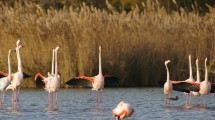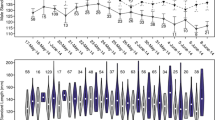Abstract
In most species females do not exhibit conspicuous sexual behaviours and female mate preferences are often measured by means of the time spent close to males. In spite of its widespread use, in only a few studies has this measure been validated as a reliable indicator of female mate preference. Sex-role-reversed species offer a better opportunity to test female preferences, as females usually court males. We tested in a sex-role-reversed population of the blenny Salaria pavo (Risso) if the time spent by females close to males related to the number of courtship displays directed towards males, and whether these measures of female preference reliably predicted matings. Females were simultaneously presented with two males behind a glass partition and the time spent close to each male was measured. We then allowed females to have access to the males' compartments and measured the courtship behaviours performed by females towards each male and recorded with which of the males females spawned. Females spent more time close to the male that subsequently received more courtship displays, and the preferred male had a more developed head crest. However, both measures of female preference failed to predict matings. Females were often attacked by males and probably had, in some occasions, to spawn with the less preferred male. Females that spawned with the previously preferred male had more swollen bellies than females that spawned with the less preferred male, suggesting a male preference towards more ripe females. These results validate the use of "time spent close to a sexual partner" as a measure of female preference in S. pavo. We argue that matings may not always reliably indicate mate preferences, particularly in the less choosy sex.


Similar content being viewed by others
References
Almada VC, Gonçalves EJ, Santos AJ, Baptista C (1994) Breeding ecology and nest aggregations in a population of Salaria pavo (Pisces: Blenniidae) in an area where nest sites are very scarce. J Fish Biol 45:819–830
Almada VC, Gonçalves EJ, Oliveira RF, Santos AJ (1995) Courting females: ecological constraints affect sex roles in a natural population of the blenniid fish, Salaria pavo. Anim Behav 49:1125–1127
Andersson M (1994) Sexual selection. Princeton University Press, Princeton, N.J.
Basolo AC (1990) Female preference for male sword length in the green swordtail, Xiphophorus helleri (Pisces: Poecilidae). Anim Behav 40:332–338
Berglund A, Rosenqvist G, Svensson I (1986) Mate choice, fecundity and sexual dimorphism in two pipefish species (Synganthidae). Behav Ecol Sociobiol 19:301–307
Couldridge VCK, Alexander GJ (2001) Does the time spent near a male predict female mate choice in a Malawian cichlid? J Fish Biol 59:667–672
Darwin C (1859) On the origin of species by means of natural selection. Murray, London
Darwin C (1871) The descent of man, and selection in relation to sex. Murray, London
Fishelson L (1963) Observations on littoral fishes of Israel I. Behaviour of Blennius pavo Risso (Teleostei: Blenniidae). Isr J Zool 12:67–80
Forsgren E (1992) Predation risk affects mate choice in a gobiid fish. Am Nat 140:1041–1049
Gonçalves D, Simões PC, Chumbinho AC, Correia MJ, Fagundes T, Oliveira RF (2002a) Fluctuating asymmetries and reproductive success in the peacock blenny, Salaria pavo (Risso). J Fish Biol 60:810–820
Gonçalves DM, Barata EN, Oliveira RF, Canário AVM (2002b) The role of male visual and chemical cues on the activation of female courtship behaviour in the sex-role reversed peacock blenny. J Fish Biol 61:96–105
Gonçalves EJ, Almada VC, Oliveira RF, Santos AJ (1996) Female mimicry as a mating tactic in males of the blenniid fish Salaria pavo. J Mar Biol Assoc UK 76:529–538
Itzkowitz M, Draud MJ, Barnes JL, Haley M (1998) Does it matter that male beaugregory damselfish have a mate preference? Behav Ecol Sociobiol 42:149–155
Jennions MD, Petrie M (1997) Variation in mate choice and mating preferences: a review of causes and consequences. Biol Rev 72:283–327
Kodric-Brown A (1985) Female preference and sexual selection for male coloration in the guppy (Poecilia reticulata). Behav Ecol Sociobiol 17:199–205
Kodric-Brown A, Nicoletto PF (1997) Repeatability of female choice in the guppy: response to live and videotaped males. Anim Behav 54:369–376
Landmann K, Parzefall J, Schlupp I (1999) A sexual preference in the Amazon molly, Poecilia formosa. Environ Biol Fish 56:325–331
Magnhagen C, Kvarnemo C (1989) Big is better: the importance of size for reproductive success in male Pomatoschistus minutus (Pallas) (Pisces: Gobiidae). J Fish Biol 35:755–763
Milinski M, Baker TCM (1990) Female sticklebacks use male coloration in mate choice and hence avoid parasitized males. Nature 344:330–333
Oliveira RF, Almada VC, Forsgren E, Gonçalves EJ (1999) Temporal variation in male traits, nest aggregations and mating success in the peacock blenny, Salaria pavo. J Fish Biol 54:499–512
Papaconstantinou CA (1979) Secondary sex characters of blennioid fishes (Pisces: Blenniidae). Thalassographica 1:57–75
Patzner RA, Seiwald M (1987) The reproduction of Blennius pavo II. Secondary sexual organs and accessory glands of the testis during the reproductive cycle. In: Kullander S, Fernholm B (eds) Proceedings of the V congress of European ichthyologists. Swedish Museum of Natural History, Stockholm, pp 293–298
Patzner RA, Seiwald M, Adlgasser M, Kaurin G (1986) The reproduction of Blennius pavo V. Reproductive behaviour in natural environment. Zool Anz 216:338–350
Rosenqvist G (1990) Male mate choice and female-female competition for mates in the pipefish Nerophis ophidion. Anim Behav 39:1110–1115
Rowland WJ (1982) Mate choice by male sticklebacks. Anim Behav 30:1093–1098
Rowland WJ (1989) The ethological basis of mate choice in male threespine sticklebacks, Gasterosteus aculeatus. Anim Behav 38:112–120
Ryan MJ, Hews DK, Wagner WE Jr (1990) Sexual selection on alleles that determine body size in the swordtail Xiphophorus nigrensis. Behav Ecol Sociobiol 26:231–237
Sargent RC, Gross MR, Bergh EP van den (1986) Male mate choice in fishes. Anim Behav 34:545–550
Schlupp I, Marler C, Ryan MJ (1994) Benefit to male sailfin mollies of mating with heterospecific females. Science 263:373–374
Vagelli A (1999) The reproductive biology and early ontogeny of the mouthbrooding banggai cardinalfish, Pterapogon kauderni (Perciformes, Apogonidae). Environ Biol Fish 56:79–92
Zander CD (1986) Blenniidae. In: Whitehead PJP, Bauchot ML, Hureau JC, Nielsen J, Tortonese E (eds) Fishes on the north-eastern Atlantic and the Mediterranean. Unesco, Paris, pp 1096–1112
Acknowledgements
We acknowledge the Ria Formosa Nature Park for providing essential logistical and technical support. During this study D.M.G. was funded by a PRAXIS XXI Ph.D. grant (BD/13436/97).
Author information
Authors and Affiliations
Corresponding author
Additional information
Communicated by R. Serrão Santos
Rights and permissions
About this article
Cite this article
Gonçalves, D.M., Oliveira, R.F. Time spent close to a sexual partner as a measure of female mate preference in a sex-role-reversed population of the blenny Salaria pavo (Risso) (Pisces: Blenniidae). acta ethol 6, 1–5 (2003). https://doi.org/10.1007/s10211-003-0083-8
Received:
Revised:
Accepted:
Published:
Issue Date:
DOI: https://doi.org/10.1007/s10211-003-0083-8




